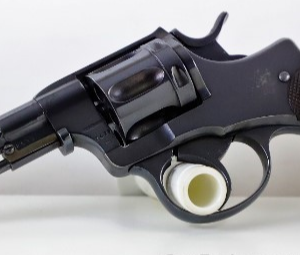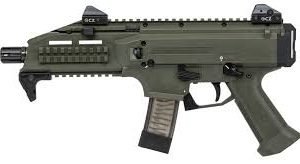Husqvarna M1885 7.5 Nagant
$630.00 Original price was: $630.00.$600.00Current price is: $600.00.
Husqvarna M1885 7.5 Nagant

The 3-line rifle M1891 is popularly known in the West as the Mosin Nagant and in Russia as the Mosin nagant rifle. The mosin nagant for sale is a five-shot, bolt-action, internal magazine–fed, military rifle. Also, It is one of the most mass-produced military bolt-action rifles in history. Hence it has over 37 million units having been made since its inception in 1891. It is primarily found chambered for its original 7.62×54mmR
Husqvarna M1885 7.5 Nagant
The Mosin nagant 3-line rifle, Model 1891 was adopted by the Russian military in 1891. There have been several variations from the original rifle, the most common being the M1891/30 (commonly referred to as “the 91/30” by shooters). Also, Some details were borrowed from the mosin Nagant for sale design.Furthermore, the 1891 Mosin nagant rifle for sale uses two front-locking lugs to lock up the action.
Husqvarna M1885 7.5 Nagant
However, the Mosin’s lugs lock in the horizontal position, whereas the Mauser locks vertically. The Mosin nagant bolt body is also multi-piece whereas the Mauser is one piece. Like the Mauser, the Mosin nagant uses a blade ejector mounted in the receiver. The Mosin nagant bolt is removed by simply pulling it fully to the rear of the receiver and squeezing the trigger. Meanwhile the Mauser has a bolt stop lever separate from the trigger.
Husqvarna M1885 7.5 Nagant
Like the Mauser, the bolt lift arc on the Mosin–Nagant is 90 degrees, versus 60 degrees on the Lee–Enfield. Furthermore, the Mauser bolt handle is at the rear of the bolt body. It locks behind the solid rear receiver ring. Hence the Mosin nagant bolt handle is similar to the Mannlicher: The rifling of the Mosin nagant for sale barrel is right turning (clockwise looking down the rifle) 4-groove with a twist of 1:9.5″ or 1:10″. Also the 5-round fixed metallic magazine can either be loaded by inserting the cartridges singly, or more often in military service, by the use of 5-round stripper.
Husqvarna M1885 7.5 Nagant
One of the last single-shot rifles produced for a European power was the 8mm Guedes rifle. It was a falling block weapon with a single shot, comparable to the Peabody-Martini. The Guedes rifle is named after Lt Luis Guedes Dias, who was chiefly responsible for creating it for use with an 11mm cartridge in 1882-4.
The Portuguese, on the other hand, understood that a new small bore caliber would be far more desirable, so they had them produced for a new 8 x 60mm rimmed cartridge. Before the Guedes were dispatched, the rifles were obsolete, and Portugal had already placed orders for new M1886 Kropatschek bolt action repeating rifles. The bayonets and cartridges for the Guedes are conveniently identical.
Unknown, although smaller quantities traveled to the OFS (Orange Free State) and can be discovered with the letters “O.V.S.” on them. An excellent history of Portuguese military weapons may be found at: https://carbinesforcollectors.com/port1.html This example is in excellent shape throughout, with a beautiful bore (as if anyone has any 8mm Guedes/Kropatschek ammo lying around to shoot).
Husqvarna M1885 7.5 Nagant
Metal pieces with about 75-80% original blue exhibiting wear, thinning, and some pluming, all honest wear. With a minor chip on the right rear corner of the forend, the wood displays varied dings from wartime field use in a tough environment. A 3/8” diameter hole has been drilled in the butt and forend, indicating that it was used as a sli.
The revolver was made in Liege, Belgium, by the Nagant company. The output speed was 240 m/s and the weight was 0.8 kg, resulting in a flat trajectory and great penetration ability. The weapon was simple to disassemble, and the double action system could also be cocked and discharged single action, just like older revolvers.
The weapon was adopted as a Swedish officer revolver m/87 after a few minor changes (the grip was enlarged by one centimeter and the sights were slightly modified).
The revolver’s only remaining flaw was that the drum could be turned while the hammer was still down. Lieutenant T F Törnell had already patented a device in 1888.
Husqvarna M1885 7.5 Nagant
Even enlisted men received m/87 in 1898, which necessitated the procurement of vast quantities of weaponry. Husqvarna took up the production and produced around 14.000 revolvers in total. In 1891, the Swedish Navy purchased a number of m/87.
In 1889, the Norwegian Navy had already done so. In 1893, the Norwegian arm switched from the 9 mm Nagant to the Swedish 7.5 mm. The m/87 was replaced by the 9 mm Browningpistol (m/07) after 20 years. However, in total defense, the revolver lasted a long time. It was carried by the “Swedish Landstorm” army formations during the First World War, and it was also seen in some local defense troops during the Second World War. The most recent service was a ma
Husqvarna M1885 7.5 Nagant
For safety after WWII, each significant industry had its own military organization, such as a house guard. Husvarna delivered a big number of these revolver m/87 to these major factories in 1954 and 1955. Husqvarna purchased these revolvers from the Swedish Ordnance and had them repaired.

On the commercial market, 138 revolvers have been sold. There are no Army numbers on these revolvers. About 20 of these were sold to industrial managers and personnel.
Master engraver Hasse Svensson etched five m/1887 revolvers as luxury editions.
Under the lid of the officer’s holster m/95 for revolver m/87, there should be room for 12 cartridges, but later on, even 6 were approved.
Husqvarna M1885 7.5 Nagant
The 1884 commission was pleased by the Swiss 7.5 mm cartridge employed in the m/87 because of its fast beginning speed and penetrating capability, especially in wood. Even by archaic standards, though, it was not a strong cartridge. The starting velocity and impact energy of certain contemporaneous and more recent calibers are depicted graphically below.
Husqvarna M1885 7.5 Nagant

The 3-line rifle M1891 is popularly known in the West as the Mosin Nagant and in Russia as the Mosin nagant rifle. The mosin nagant for sale is a five-shot, bolt-action, internal magazine–fed, military rifle. Also, It is one of the most mass-produced military bolt-action rifles in history. Hence it has over 37 million units having been made since its inception in 1891. It is primarily found chambered for its original 7.62×54mmR
Husqvarna M1885 7.5 Nagant
The Mosin nagant 3-line rifle, Model 1891 was adopted by the Russian military in 1891. There have been several variations from the original rifle, the most common being the M1891/30 (commonly referred to as “the 91/30” by shooters). Also, Some details were borrowed from the mosin Nagant for sale design.Furthermore, the 1891 Mosin nagant rifle for sale uses two front-locking lugs to lock up the action.
Husqvarna M1885 7.5 Nagant
However, the Mosin’s lugs lock in the horizontal position, whereas the Mauser locks vertically. The Mosin nagant bolt body is also multi-piece whereas the Mauser is one piece. Like the Mauser, the Mosin nagant uses a blade ejector mounted in the receiver. The Mosin nagant bolt is removed by simply pulling it fully to the rear of the receiver and squeezing the trigger. Meanwhile the Mauser has a bolt stop lever separate from the trigger.
Husqvarna M1885 7.5 Nagant
Like the Mauser, the bolt lift arc on the Mosin–Nagant is 90 degrees, versus 60 degrees on the Lee–Enfield. Furthermore, the Mauser bolt handle is at the rear of the bolt body. It locks behind the solid rear receiver ring. Hence the Mosin nagant bolt handle is similar to the Mannlicher: The rifling of the Mosin nagant for sale barrel is right turning (clockwise looking down the rifle) 4-groove with a twist of 1:9.5″ or 1:10″. Also the 5-round fixed metallic magazine can either be loaded by inserting the cartridges singly, or more often in military service, by the use of 5-round stripper.
Husqvarna M1885 7.5 Nagant
One of the last single-shot rifles produced for a European power was the 8mm Guedes rifle. It was a falling block weapon with a single shot, comparable to the Peabody-Martini. The Guedes rifle is named after Lt Luis Guedes Dias, who was chiefly responsible for creating it for use with an 11mm cartridge in 1882-4.
The Portuguese, on the other hand, understood that a new small bore caliber would be far more desirable, so they had them produced for a new 8 x 60mm rimmed cartridge. Before the Guedes were dispatched, the rifles were obsolete, and Portugal had already placed orders for new M1886 Kropatschek bolt action repeating rifles. The bayonets and cartridges for the Guedes are conveniently identical.
Unknown, although smaller quantities traveled to the OFS (Orange Free State) and can be discovered with the letters “O.V.S.” on them. An excellent history of Portuguese military weapons may be found at: https://carbinesforcollectors.com/port1.html This example is in excellent shape throughout, with a beautiful bore (as if anyone has any 8mm Guedes/Kropatschek ammo lying around to shoot).
Husqvarna M1885 7.5 Nagant
Metal pieces with about 75-80% original blue exhibiting wear, thinning, and some pluming, all honest wear. With a minor chip on the right rear corner of the forend, the wood displays varied dings from wartime field use in a tough environment. A 3/8” diameter hole has been drilled in the butt and forend, indicating that it was used as a sli.
Husqvarna M1885 7.5 Nagant
Husqvarna M1885 7.5 Nagant

Husqvarna M1885 7.5 Nagant
Husqvarna M1885 7.5 Nagant
Husqvarna M1885 7.5 Nagant
Husqvarna M1885 7.5 Nagant
The 9 mm revolvers were approved on June 4, 1883, based on the test findings.
Husqvarna M1885 7.5 Nagant
Husqvarna M1885 7.5 Nagant
Husqvarna M1885 7.5 Nagant
Husqvarna M1885 7.5 Nagant
Husqvarna M1885 7.5 Nagant
Husqvarna M1885 7.5 Nagant
Husqvarna M1885 7.5 Nagant

Reviews
There are no reviews yet.
Related products
Kriss Vector
Mosin Nagant For Sale
Mosin Nagant For Sale
Mosin Nagant For Sale
Chiappa rhino
Mosin Nagant For Sale
CZ Scorpion
CZ Scorpion











Be the first to review “Husqvarna M1885 7.5 Nagant”